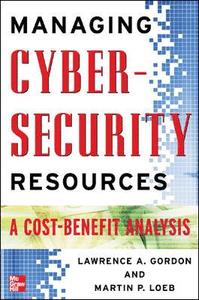
Managing Cybersecurity Resources
According to the CERT Coordination Center, which has been collecting data on cyber (meaning Internet) security incidents since 1988, security breaches have been on a dramatic rise. In 1998, 3734 security-related incidents were reported; in the first three quarters of 2003 alone the number of breaches was at an all-time high of 114,855. Cyber and information security has become one of the number one issues facing corporations today. Breaches are not only costly but as the authors research shows can also affect a stock price. And in the age of terrorism, numerous government agencies have also become interested in cyber and information security in a big way. Given the high stakes of today's information security decisions, a framework for sound decision-making using such tools as cost-benefit analysis is needed. The Management of Information Security presents a framework using financial management guidelines allowing organizations to efficiently manage information security resources. The authors' research has propelled them as leaders in this area and they have been sought out by numerous government agencies and corporations (see attached list).Gordon and Loeb help managers and executives answer key questions that surround the decision-making process when determining how to allocate resources for information security purposes. Readers will find information on such topics as: How do firms deal with financial constraints? What models can firms use to determine how much to spend on security? How much information sharing can a firm conduct without losing competitive advantage? While other aspects of financial management have long been in place, few firms are prepared to tackle the issue of allocating resources for security purposes. As the leading names in the area, Gordon & Loeb share crucial information with managers and executives charged with managing the resources for this critical area.
Utgiven: 2005
ISBN: 9780071452854
Förlag: McGraw-Hill Professional
Format: Inbunden
Språk: Engelska
Sidor: 224 st
According to the CERT Coordination Center, which has been collecting data on cyber (meaning Internet) security incidents since 1988, security breaches have been on a dramatic rise. In 1998, 3734 security-related incidents were reported; in the first three quarters of 2003 alone the number of breaches was at an all-time high of 114,855. Cyber and information security has become one of the number one issues facing corporations today. Breaches are not only costly but as the authors research shows can also affect a stock price. And in the age of terrorism, numerous government agencies have also become interested in cyber and information security in a big way. Given the high stakes of today's information security decisions, a framework for sound decision-making using such tools as cost-benefit analysis is needed. The Management of Information Security presents a framework using financial management guidelines allowing organizations to efficiently manage information security resources. The authors' research has propelled them as leaders in this area and they have been sought out by numerous government agencies and corporations (see attached list).Gordon and Loeb help managers and executives answer key questions that surround the decision-making process when determining how to allocate resources for information security purposes. Readers will find information on such topics as: How do firms deal with financial constraints? What models can firms use to determine how much to spend on security? How much information sharing can a firm conduct without losing competitive advantage? While other aspects of financial management have long been in place, few firms are prepared to tackle the issue of allocating resources for security purposes. As the leading names in the area, Gordon & Loeb share crucial information with managers and executives charged with managing the resources for this critical area.
Begagnad bok (0 st)
Varje vecka tillkommer tusentals nya säljare. Bevaka boken så får du meddelande när den finns tillgänglig igen.



